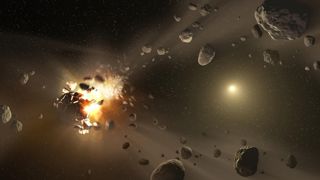
The Day A Meteorite Landed On Barwell
- 21st Jun 2017
- Author: Kevin Yates
It’s 1965 and America and the Soviet Union are flexing their technological muscles as the race for dominance in space gains momentum. Ed White and Alexei Leonov have both completed the first space walks for their respective nations. Space has never seemed closer, or featured so prominently in public consciousness.
Meanwhile the sci-fi movie, Night Caller from Outer Space, is showing at cinemas around the UK. This film tells the story of scientists investigating a meteorite fall in the British countryside. It turns out to actually be an alien device from Jupiter’s moon, Ganymede.
Given this setting, it is easy to see how the fall of a genuine rock from space, in the village of Barwell, completely captured the imagination of the public and media at the time.
The fall occurred around 16:20 on Christmas Eve. One Barwell resident, Mr Crow, was walking home from work when he saw a flash in the sky accompanied by a loud bang. A few moments later he described hearing a ‘swish’ followed by a thud as one of the first pieces landed on the ground nearby. This was followed by several other pieces landing in quick succession.
Carol singers were out that evening and recalled a crunching noise underfoot as they walked around the village. One of the carol singers was 26-year-old Rosemary Leader. She picked up a piece of the rock, but threw it away after examining it under a street light. She recalls, “I was out carol singing, I didn’t want to carry a lump of rock around.”
Being Christmas Eve, life went on regardless for the next couple of days. The first official report of the incident was made by Mr Grewcock (a neighbour of Mr Crow) to local police officer P.C. Scott on 27 December.
P.C. Scott himself recalled seeing a lightning-like flash on the afternoon in question, which came from the direction of Hinckley, 2 miles south west of Barwell. Later reports would confirm that the flash was witnessed by people 12 miles away in Coventry.
Only two pieces of the space rock were recovered on the day of the fall. The first landed on a road, forming a small crater. It shattered into several pieces, a fragment of which went through Mr Grewcock’s front room window. It landed in a vase of imitation flowers where it remained, amazingly, undiscovered for 19 days.
The second piece recovered that day landed on the bonnet of a Vauxhall Viva, recently purchased by Percy England. He initially threw the rock away, thinking it was a lump of concrete thrown by vandals. His car insurance claim was refused on the basis that it was ‘an act of God’. Apparently, Percy then went to his local priest to see if the Church would pay for repairs to his car. No money was offered!
Several more pieces were recovered on Christmas Day and eventually handed into the police, who sent samples to Leicester Museum, the University of Leicester, the Geological Survey, and the Natural History Museum.
Experts from these institutions confirmed that the meteorite was a chondrite – a type of meteorite composed
of tiny droplets of rock known as chondrules. These experts met in Barwell on 6 January 1966 to examine other specimens held by the police and to search for more pieces.
Dr Ford of the University of Leicester found a large piece of the meteorite not far from Mr Crow and Mr Grewcock’s houses on The Common, a road that leads into the centre of Barwell. By 9 January a total of 20 kilograms of material had been recovered.
Watch: Experts describe the Barwell meteorite of 1965 in a BBC broadcast
In February 1966, an attempt was made to piece together all of the collected fragments. Only two pieces were found to be a good fit, and the team concluded that a significant amount of the meteorite was still to be recovered. They decided to offer to purchase any fragments of the space rock and local newspapers spread the news. This led to an influx of material, including the largest piece recovered, which weighed 7.7 kilograms. It was found buried 75 centimetres below the surface in a hole near the Pavilion of the local Recreation Ground.
Among those to visit Barwell during the early days was public astronomer and Sky At Night presenter, Patrick Moore. He found a chunk of the meteorite and offered it to the local museum. He later said, “They told me ‘we have plenty of it so you can keep it for display as long as you make sure it comes to us in your will’ ”.
The sample of the Barwell meteorite on display at the National Space Centre is the third largest recovered. It was found on 5 March 1966 on a disused allotment about 170 metres south east of Mr Crow’s house. Its impact had created a 45-centimetre-deep crater in rough grassland. Today, it is still possible to see some of the mud on the meteorite from when it was first recovered.
Barwell is the largest and best recorded meteorite fall in British history. Although our exploration and understanding of space has moved on enormously since those first tentative steps in the 1960s, it is still thrilling to get close to this visitor from an ancient world.
About the author: Kevin Yates is the Exhibition Development Manager at the National Space Centre.






